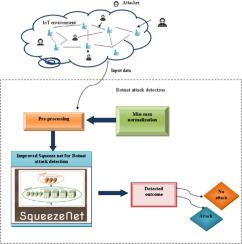Enhanced SqueezeNet model for detecting IoT-Bot attacks: A comprehensive approach
IF 1.9
Q2 MULTIDISCIPLINARY SCIENCES
引用次数: 0
Abstract
The exponential growth of Internet of Things (abbreviated as IoT) has led to a surge in cyber threats, especially botnet attacks that compromise network security. Although machine learning (abbreviated ML) & deep learning (abbreviated as DL) approaches have shown promise in detecting these attacks, they often struggle with limited accuracy & high computational requirements, making them unsuitable for real-time detection in resource-constrained IoT environments. To overcome these limitations, this research proposes an enhanced detection framework based on an improved SqueezeNet model integrated with a Deep Convolutional Neural Network (abbreviated as DCNN) and an optimized stochastic mixed Lp layer. This model aims to improve detection accuracy while maintaining computational efficiency. Experimental evaluation using a large-scale intrusion detection dataset demonstrates that the proposed model significantly outperforms existing techniques such as Bi-GRU, CNN, PolyNet, and LinkNet, achieving a classification accuracy of 0.97 and a reduced false positive rate of 0.054. The complete research process is outlined below:
- •Data Pre-processing: Min-max normalization is applied to the input dataset to ensure consistent data scaling and enhance model learning performance.
- •Feature Extraction and Classification: The improved SqueezeNet is integrated with DCNN & a stochastic mixed Lp layer to extract meaningful features and classify attacks accurately.
- •Model Evaluation: Performance is validated through accuracy, precision, recall, and false positive rate using a benchmark intrusion detection dataset.

用于检测IoT-Bot攻击的增强型SqueezeNet模型:一种综合方法
物联网(简称IoT)的指数级增长导致了网络威胁的激增,尤其是危及网络安全的僵尸网络攻击。虽然机器学习(简称ML) &;深度学习(简称DL)方法在检测这些攻击方面显示出了希望,但它们通常在有限的准确性上挣扎。计算要求高,不适合在资源受限的物联网环境中进行实时检测。为了克服这些限制,本研究提出了一种基于改进的SqueezeNet模型的增强检测框架,该模型集成了深度卷积神经网络(简称DCNN)和优化的随机混合Lp层。该模型旨在提高检测精度的同时保持计算效率。使用大规模入侵检测数据集进行的实验评估表明,该模型显著优于Bi-GRU、CNN、PolyNet和LinkNet等现有技术,分类准确率达到0.97,误报率降低至0.054。完整的研究过程概述如下:•数据预处理:对输入数据集应用最小-最大归一化,以确保数据缩放一致,提高模型学习性能。•特征提取和分类:改进的SqueezeNet与DCNN集成;随机混合Lp层提取有意义的特征,准确分类攻击。•模型评估:使用基准入侵检测数据集通过准确性、精密度、召回率和误报率来验证性能。
本文章由计算机程序翻译,如有差异,请以英文原文为准。
求助全文
约1分钟内获得全文
求助全文
来源期刊

MethodsX
Health Professions-Medical Laboratory Technology
CiteScore
3.60
自引率
5.30%
发文量
314
审稿时长
7 weeks
期刊介绍:
 求助内容:
求助内容: 应助结果提醒方式:
应助结果提醒方式:


